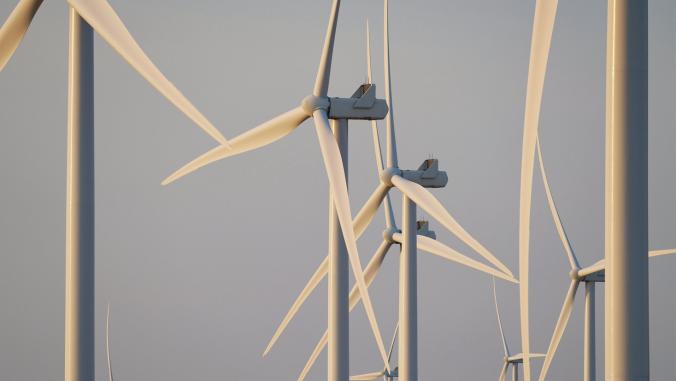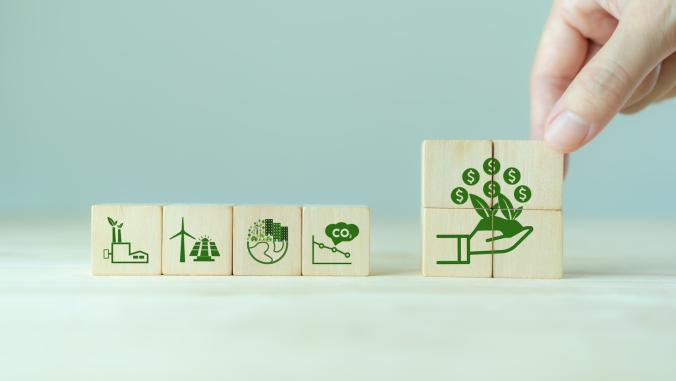Apple, Ikea and the quest for Zero Net Energy
A look at the big-name businesses trying to neutralize — not just reduce — the environmental impact of their power consumption.

For a growing number of companies, fighting climate change is a zero-sum game.
In late September, several organizations associated with nonprofit sustainability outfit The B Team declared a "net zero by 2050" (PDF) aspiration pertaining to greenhouse gas emissions.
Among them: consumer products giant Unilever; apparel company Kering; Chinese construction company Broad Group; African telecommunications carrier Econet; Brazilian cosmetics manufacturer Natura; and British-born investment group Virgin — a geographically diverse group that underscores the global nature of climate challenges.
"We are proud to have been carbon neutral since 2007, but this certainly doesn’t go far enough,” Natura co-founder Guilherme Leal said in a statement. “At Natura, we have committed to generate positive impact socially and environmentally by 2050. The effects of climate change hit the poorest hardest. Businesses from the developing world also have the responsibility to join this effort and the opportunity to innovate and generate prosperity in the pursuit of ‘net-zero.’"
At a high level, defining Zero Net Energy is pretty straightforward — even for the math-challenged. It speaks to a state of harmony in which humans give back as much as they take.
The U.S. Department of Energy also just spent a whole year creating a "standard" set of definitions for various zero energy concepts. The resulting 22-page report notes:
Projects seeking to verify zero energy should work to ensure no harm is done in the process of achieving zero energy performance across other, energy-related considerations such as water protection, optimized comfort for low-load buildings and comprehensive indoor air quality. While these considerations don't affect the definition of zero energy, it is important that in practice a design team ensures that other important building considerations and values are not sacrificed in pursuit of zero energy.
One building at a time
For the past decade, the net zero energy label has been applied most frequently to buildings — although the focus has become much broader over the past two years, as the DOE indicated.
One commercial example cited most often as an illustration of what’s possible, at least in certain locations: the Bullitt Center built by Earth Day founder Denis Hayes in Seattle.
[Learn more about getting zero-net-energy buildings to scale at VERGE 2015 Oct. 26 to 29 in San Jose, California.]
So far, it’s the largest building to be certified as net-positive for water and energy under the Living Building Challenge. But the new 2.8-million-square-foot Apple headquarters site in Cupertino, California, will be another high-profile achievement. The campus is slated for completion in 2016.
Interest in designing net-zero buildings has been driven in large part by regulations, such as the Energy Performance of Buildings Directive in the European Union and the Title 24 building code in California. Revenue associated with projects could reach $1.4 trillion by 2025, according to projections from Navigant Research.
"The global zero energy building market has many pockets of potential growth, but challenges remain in defining what exactly a [zero energy building] is, as well as raising awareness of the increasing accessibility of these solutions," said Noah Goldstein, Navigant research director.
The clarion call of energy independence
A growing number of companies and communities are looking beyond individual buildings, however, linking net-zero commitments to their entire electricity footprint. This underscores the realization that simply reducing consumption, mitigating harm done to the environment, won’t be enough to reverse global warming.
Swedish furniture retailer IKEA Group is among the most aggressive advocates for a net-zero energy future. Its goal by August 2020 is to produce as much renewable energy as it consumes in its operations. To get there, it is making a $2 billion investment in renewable energy projects, including a massive wind farm in Illinois that will product 165 percent of the electricity needed to run its U.S. operations.
"We are committed to renewable energy and to running our business in a way that minimizes our carbon emissions, not only because of the environmental impact, but also because it makes good financial sense," said Rob Olson, chief financial officer of IKEA US, when the investment was disclosed. "We invest in our own renewable energy sources so that we can control our exposure to fluctuating electricity costs and continue providing great value to our customers."
For perspective, the farm referenced above will produce about 380 gigawatt-hours of electricity annually, enough to cover 34,000 American households. That is also roughly the amount of power needed to run 70 IKEA stores.
Apple’s attention to net-zero energy is also attracting considerable notice. Its stance, according to the technology giant’s latest sustainability report (PDF): "An energy-efficient facility is good, but a 100 percent renewable energy facility is better."
As of the end of fiscal year 2014, Apple had invested in enough renewable energy generation to power 87 percent of its worldwide operations — and all of its U.S. corporate footprint. That includes its data centers (where it increasingly serves as a model for other major cloud services companies), more than 450 retail stores worldwide and offices that house nearly 50,000 employees.
The company notes:
Where it’s not feasible to create all our own energy, we fulfill the remaining needs with grid-purchased renewable energy, preferably delivered to our facilities or to the same electric grid in which our facilities are located. Here we have been exceptionally rigorous on two fronts: first, in ensuring that grid-purchased renewable energy be from newer projects, with the objective of providing investment incentives to local providers; and second, to secure renewable energy from the grid in the region in which we use it.
Like many other companies, Apple is using renewable energy credits to fill the gap. That’s the strategy being used, for example, by data center operator Equinix.
The company last week signed a power purchase agreement for a solar farm in southern California. The electricity generated at the site will offset about 300 megawatt hours of power needed to run Equinix’s California operations.
Communities small and large are also talking up broad net-zero energy ambitions. The tiny, 2,640-resident town of Bloomfield, Iowa, is exploring a range of investments including geothermal and solar technologies. Yes, the goal is net zero.
Perhaps more important, however, is the vision of energy independence that is helping planners make the case.
“It’s about having a powerful role and self-determination in how energy positively impacts your community,” said Jason Meyer, a senior associate with the Rocky Mountain Institute, who because involved with Bloomfield through the RMI Accelerator program.





